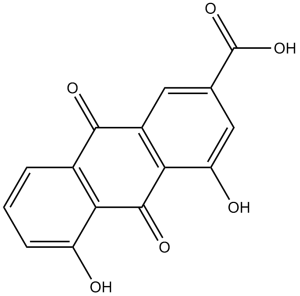
| 规格 | 价格 | 库存 | 数量 |
|---|---|---|---|
| 100mg |
|
||
| 250mg |
|
||
| 500mg |
|
||
| 1g |
|
||
| 2g | |||
| 5g | |||
| Other Sizes |
| 体外研究 (In Vitro) |
大黄酸以剂量依赖性方式降低 NB4 细胞活力(0-80 μM,72 小时)[2]。大黄酸(5 μM,72 小时)可增强 ATRA 激活的 NB4 细胞以及半贴壁巨噬细胞样细胞中 ROS 的形成和吞噬作用,以及 CD11b、CD14、CCR-1 和 CCR- 的表达。 2 [2]。大黄酸(5 μM,72 小时)抑制 mTOR 通路并引发 NB4 细胞凋亡 [2]。在 MCF-7 和 MDA-MB-435 细胞中,大黄酸(50-200 μM,48 小时)可抑制血管生成 [4]。大黄酸(0-50 μM,24 小时)可抑制 HUVEC 增殖、迁移、侵袭和管形成(抑制上清液中的 VEGF165、EGF 和核提取物中的 HIF-1α)[4]。
|
|---|---|
| 体内研究 (In Vivo) |
在大鼠中,大黄酸(10-40 mg/kg,ig)可以预防对乙酰氨基酚引起的肝脏和肾脏损伤[3]。
|
| 细胞实验 |
RT-PCR[2]
细胞类型:急性早幼粒细胞白血病 (APL) 细胞(NB4 细胞) 测试浓度: 5 μM 孵育时间:72 小时 实验结果:PU.1、C/EBPA 和 C/EBPE 的 mRNA 表达增加。 ATRA 激活的 CCR1 和 CCR2 mRNA 表达增加。 蛋白质印迹分析[2] 细胞类型: NB4 细胞 测试浓度: 0-40 μM 孵育时间:48 和 72 小时 实验结果:增加了 cleaved caspase-3、Bax 的表达。减少Bcl-xl、procaspase-3的表达。 |
| 动物实验 |
Animal/Disease Models: 2.5 g/kg APAP (ig) induced rats[3]
Doses: 10, 20 and 40 mg/kg Route of Administration: ig Experimental Results: Ameliorated histopathological damage of liver and kidney. decreased GPT, GOT, UREA and CREA levels and ROS production. Restored NO, MDA, GSH contents. |
| 药代性质 (ADME/PK) |
Absorption, Distribution and Excretion
Tmax of 1.6-2.6 hours. 37% is excreted in urine and 53% in feces as estimated in rats. 15-60L. Total CL is 1.5 L/h and renal CL is 0.1 L/h. Metabolism / Metabolites Metabolized primarily to rhein glucuronide and rhien sulfate. Biological Half-Life 4-10h. |
| 毒性/毒理 (Toxicokinetics/TK) |
Protein Binding
99% bound to plasma proteins. |
| 参考文献 |
|
| 其他信息 |
Pharmacodynamics
**Liver: **Reverses animal models of non-alcoholic fatty liver disease by lowering liver lipids and reducing inflammation. Also reverses and prevents fibrosis in liver injury. **Kidney: **Protects against fibrosis in nephropathy models and improves epithelial tight junction function. **Bone and joint:** Decreases inflammation and cartilage destruction and also corrects altered osteoblast acitivity. **Lipid lowering and anti-obesity:** Reduces body weight and fat content, and lowers high density lipoprotein and low density lipoprotein. May prevent adipocyte differentiation. **Anti-oxidant/Pro-oxidant**: Reduces levels of reactive oxygen species (ROS) at concentrations of about 2-16 microM but induces the generation of ROS at concentrations of 50 microM and above. **Anti-cancer:** Rhein has been observed to produce DNA damage and suppress DNA repair in cancer cells. It induces apoptosis via ER stress, calcium, and mitochondria mediated pathways. Rhein also prevents cancer cell invasion into systemic circulation by preventing angiogenesis and breakdown of the extracellular matrix. Finally, rhein suppresses the activation of several tumor promoting signalling pathways. **Anti-inflammatory: ** Suppresses the production of pro-inflammatory cytokines such as interleukin-1beta and interleukin-6. **Anti-diabetic: **Lowers plasma glucose and increases survival of islet beta cells in type 2 diabetes mellitus models. **Anti-microbial:** Inhibits arylamine N-acteyltransferase and cell growth in Helicobacter pylori. Rhien also appears to be effective against many genotypes of Staphylococcus aureus. **Anti-allergenic:** Inhibits production of leukotrienes and the release of histamine from mast cells. |
| 分子式 |
C15H8O6
|
|
|---|---|---|
| 分子量 |
284.22
|
|
| 精确质量 |
284.032
|
|
| CAS号 |
478-43-3
|
|
| 相关CAS号 |
|
|
| PubChem CID |
10168
|
|
| 外观&性状 |
Light yellow to yellow solid powder
|
|
| 密度 |
1.7±0.1 g/cm3
|
|
| 沸点 |
597.8±50.0 °C at 760 mmHg
|
|
| 熔点 |
≥300 °C(lit.)
|
|
| 闪点 |
329.4±26.6 °C
|
|
| 蒸汽压 |
0.0±1.8 mmHg at 25°C
|
|
| 折射率 |
1.761
|
|
| LogP |
4.58
|
|
| tPSA |
111.9
|
|
| 氢键供体(HBD)数目 |
3
|
|
| 氢键受体(HBA)数目 |
6
|
|
| 可旋转键数目(RBC) |
1
|
|
| 重原子数目 |
21
|
|
| 分子复杂度/Complexity |
487
|
|
| 定义原子立体中心数目 |
0
|
|
| InChi Key |
FCDLCPWAQCPTKC-UHFFFAOYSA-N
|
|
| InChi Code |
InChI=1S/C15H8O6/c16-9-3-1-2-7-11(9)14(19)12-8(13(7)18)4-6(15(20)21)5-10(12)17/h1-5,16-17H,(H,20,21)
|
|
| 化学名 |
4,5-Dihydroxyanthraquinone-2-carboxylic acid
|
|
| 别名 |
|
|
| HS Tariff Code |
2934.99.9001
|
|
| 存储方式 |
Powder -20°C 3 years 4°C 2 years In solvent -80°C 6 months -20°C 1 month |
|
| 运输条件 |
Room temperature (This product is stable at ambient temperature for a few days during ordinary shipping and time spent in Customs)
|
| 溶解度 (体外实验) |
|
|||
|---|---|---|---|---|
| 溶解度 (体内实验) |
配方 1 中的溶解度: 1.67 mg/mL (5.88 mM) in 10% DMSO + 40% PEG300 +5% Tween-80 + 45% Saline (这些助溶剂从左到右依次添加,逐一添加), 悬浮液;超声助溶。
例如,若需制备1 mL的工作液,可将100 μL 16.7 mg/mL澄清的DMSO储备液加入到400 μL PEG300中,混匀;再向上述溶液中加入50 μL Tween-80 +,混匀;然后加入450 μL生理盐水定容至1 mL。 *生理盐水的制备:将 0.9 g 氯化钠溶解在 100 mL ddH₂O中,得到澄清溶液。 请根据您的实验动物和给药方式选择适当的溶解配方/方案: 1、请先配制澄清的储备液(如:用DMSO配置50 或 100 mg/mL母液(储备液)); 2、取适量母液,按从左到右的顺序依次添加助溶剂,澄清后再加入下一助溶剂。以 下列配方为例说明 (注意此配方只用于说明,并不一定代表此产品 的实际溶解配方): 10% DMSO → 40% PEG300 → 5% Tween-80 → 45% ddH2O (或 saline); 假设最终工作液的体积为 1 mL, 浓度为5 mg/mL: 取 100 μL 50 mg/mL 的澄清 DMSO 储备液加到 400 μL PEG300 中,混合均匀/澄清;向上述体系中加入50 μL Tween-80,混合均匀/澄清;然后继续加入450 μL ddH2O (或 saline)定容至 1 mL; 3、溶剂前显示的百分比是指该溶剂在最终溶液/工作液中的体积所占比例; 4、 如产品在配制过程中出现沉淀/析出,可通过加热(≤50℃)或超声的方式助溶; 5、为保证最佳实验结果,工作液请现配现用! 6、如不确定怎么将母液配置成体内动物实验的工作液,请查看说明书或联系我们; 7、 以上所有助溶剂都可在 Invivochem.cn网站购买。 |
| 制备储备液 | 1 mg | 5 mg | 10 mg | |
| 1 mM | 3.5184 mL | 17.5920 mL | 35.1840 mL | |
| 5 mM | 0.7037 mL | 3.5184 mL | 7.0368 mL | |
| 10 mM | 0.3518 mL | 1.7592 mL | 3.5184 mL |
1、根据实验需要选择合适的溶剂配制储备液 (母液):对于大多数产品,InvivoChem推荐用DMSO配置母液 (比如:5、10、20mM或者10、20、50 mg/mL浓度),个别水溶性高的产品可直接溶于水。产品在DMSO 、水或其他溶剂中的具体溶解度详见上”溶解度 (体外)”部分;
2、如果您找不到您想要的溶解度信息,或者很难将产品溶解在溶液中,请联系我们;
3、建议使用下列计算器进行相关计算(摩尔浓度计算器、稀释计算器、分子量计算器、重组计算器等);
4、母液配好之后,将其分装到常规用量,并储存在-20°C或-80°C,尽量减少反复冻融循环。
计算结果:
工作液浓度: mg/mL;
DMSO母液配制方法: mg 药物溶于 μL DMSO溶液(母液浓度 mg/mL)。如该浓度超过该批次药物DMSO溶解度,请首先与我们联系。
体内配方配制方法:取 μL DMSO母液,加入 μL PEG300,混匀澄清后加入μL Tween 80,混匀澄清后加入 μL ddH2O,混匀澄清。
(1) 请确保溶液澄清之后,再加入下一种溶剂 (助溶剂) 。可利用涡旋、超声或水浴加热等方法助溶;
(2) 一定要按顺序加入溶剂 (助溶剂) 。